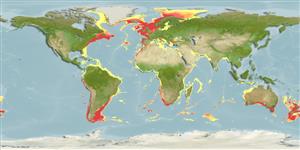Preferred temperature (Ref.
115969): 4.2 - 18.7, mean 9.9 (based on 4651 cells).
Phylogenetic diversity index (Ref.
82804): PD
50 = 0.5000 [Uniqueness, from 0.5 = low to 2.0 = high].
Bayesian length-weight: a=0.00275 (0.00237 - 0.00320), b=3.08 (3.04 - 3.12), in cm Total Length, based on LWR estimates for this species (Ref.
93245).
Trophic level (Ref.
69278): 4.4 ±0.4 se; based on diet studies.
جهندگی (Ref.
120179): خیلی آهسته, كمينه زمان لازم براي دو برابر شدن جمعيت بيش از 14 سال (rm=0.034; K=0.03-0.07; tm=10-30; tmax=75; Fec=1).
Prior r = 0.07, 95% CL = 0.05 - 0.10, Based on 10 full stock assessments.
Fishing Vulnerability (Ref.
59153): High vulnerability (64 of 100).
Climate Vulnerability (Ref.
125649): High vulnerability (62 of 100).
